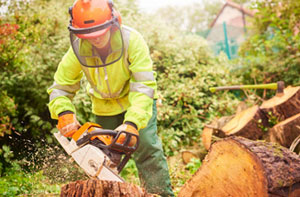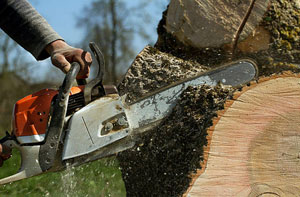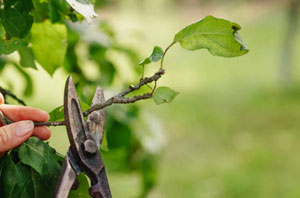Newton Abbot Tree Surgeon Devon: An attractive feature of many properties and gardens in Newton Abbot, trees add structure, substance and style to what can frequently be a dull and 2 dimensional area. But when neglected or affected by extreme weather events, for example flooding or storms, trees can be a bit of an issue. Prior to any work beginning, the best option is to get the advice of a seasoned tree surgeon in Newton Abbot, when your trees need attention.
Folks in Newton Abbot who attempt to do tree work on their own, or by using a non-qualified individual might risk causing damage to property, the trees or to life. However, even for trained tree surgeons who are aware of all the hazards, tree work is not entirely safe. In fact tree surgery is among the most dangerous jobs in the UK, with an average of a hundred and forty serious injuries and three deaths annually within the industry, and so it is definitely not safe work for amateurs to do.

A damaged or neglected tree can also present a threat to life, with around 5 people annually being tragically killed by falling trees and branches in the UK. You may well be liable to third-party compensation claims due to the consequences of your actions, if you hire someone to perform tree work and subsequently an injury, or damage to property occurs. This is why using an experienced Newton Abbot tree surgeon to undertake the work on your trees is vitally important. (Source - HSE).
CHOOSING A TREE SURGEON IN NEWTON ABBOT - There are 2 professional arboricultural bodies that a certified Newton Abbot tree surgeon should really be a signed up member of. The websites of either the AA (Arboricultural Association) or the ISA (International Society of Arboriculture) allow you to check up on the membership and professional standing of any tree surgeon in Newton Abbot. Membership of either of these 2 bodies will give the tree surgeon recognised Approved ARB Contractor status which can be checked out on this website.
If a problem develops during or after any work has been completed you are able to get hold of these professional organisations for arbitration assistance and for help and guidance at any point.

If anybody offers you an estimate for any tree work and you can't find them on this directory list, you should graciously decline their offer of work and carry on with your search for an approved tree surgeon. It is wise to get a minimum of three quotes from different companies in and around Newton Abbot, once you have meticulously checked their professional qualifications and memberships. Because of the risks involved in tree work, you should ask the below questions, making it clear that you need them to provide you with the answers:
- Do you have a NPTC certificate for the use of a chainsaw, and documentary proof of your professional memberships and qualifications? It is required by law that any worker/tree surgeon who uses a chainsaw must have a NPTC/LANTRA certificate. City and Guilds Certificates and National Diplomas in Arboriculture are qualifications that may be held by a professional tree surgeon in Newton Abbot.
- Could I contact some former customers to assess the quality of your work? It's a good idea to do an independent examination of any recent work.
- Can you offer me a quotation in writing? You should only ever accept a written quote. NEVER take a verbal quote only.
- Precisely what is your level of insurance cover? As suggested by the AA and ISA, your tree surgeon should be able to show you a certificate covering no less than five million pounds public liability insurance.
Clear and accurate details of all the tree work that's to be undertaken should be included on the written quote. It should include details of any trees which might be protected in law, and the necessary steps to obtain permission to work on them, and also state whose responsibility it is to remove waste, tree branches and stumps. You should also ensure that VAT is included on the quote unless you are a commercial entity. You have a responsibility to hire only skilled people to work on your property and trees, and it is important to understand that fact.
PRIOR TO WORK BEGINNING - The tree surgeon you have selected in Newton Abbot, will be able to investigate whether any of the trees on your property are subject to a a TPO (tree protection order), and will check with the local authority if the go-ahead for any work is forthcoming. To ensure public safety, even protected trees require maintenance in order to cut back old or dying wood, so finding that a tree is protected does not imply that you are unable to carry out necessary work.
If your property in Newton Abbot happens to be in a designated conservation area, the Local Planning Authority will require a minimum of six weeks written notice of any tree work you're planning to do. However, tree stems of less than 7.5 centimetres in diameter when measured at 1.5 metres above ground level are exempt from this requirement. Also, if the branches of a protected tree need to be pruned or thinned in order to encourage and sustain growth, written notice won't be necessary.

On site they'll complete a thorough assessment of your tree's health and determine the required remedial treatment and how the required outcome can be achieved with safety in mind. This will involve a full risk assessment of any areas that may be impacted by falling debris, such as on your property, in public areas, and on the properties of next door neighbours. At this stage, the level of protection needed and the amount of workforce required will also be determined. To keep the public and other property safe from harm or damage, this will include both PPE and other safety measures.
ON THE DAY OF WORK - Before any tree felling, climbing or cutting of branches begins, barriers and safety measures will be put in place to keep passers-by and unauthorised persons away from the area where work is going on. It might at some point be necessary to halt the traffic temporarily, if there is any threat of branches and debris falling onto the highway.
Different kinds of work will demand that the tree surgeon has different degrees of protection. When doing chainsaw work, they will at the very least be wearing specialist protective clothing to avoid cutting injuries to the hands, torso and legs. Head and eye protection, and high-vis clothing, should be worn by all workers involved in the operation.
Extra personnel will usually be needed to assist in the safe removal of high branches and heavy pieces of tree trunk, especially if working at height is involved, and where climbing equipment and ladders are being used. For taking waste materials away from the work area, a skip or truck will be stationed as close as possible to the work area. This requirement for access is as good a reason as any for informing your next door neighbours of the work.
AFTER COMPLETION OF WORK - All of the waste and branches will be hauled away and the area cleared of any debris, when all the tree work has been completed. A certificate of work done will then be prepared by your tree surgeon, particularly when the trees are protected, which will be signed off and a copy given to you. If there were any public areas that needed safety measures, this protection will be removed and highways and footpaths will be re-opened to the public.
If you've got any complaints about the work, you should get them fixed immediately by first of all speaking to your tree surgeon. If your tree surgeon is an approved member of a professional trade association, you can get help and advice from the AA or the ISA in order to come to a satisfactory solution, if any further arbitration is needed.
Local Newton Abbot tree surgery services will most likely have the telephone code 01626 and the postcode TQ12. They will work in Newton Abbot itself, in addition to nearby areas such as Ogwell, Milber, North Wilborough, East Ogwell, Combeinteignhead, Two Mile Oak, Wilborough, Abbotskerswell, Netherton, Wolborough, Penn Inn, Highweek, West Ogwell, Kingsteignton, and these postcodes: TQ12 1FR, TQ12 1AY, TQ12 1LD, TQ12 1BB, TQ12 1PL, TQ12 1EH, TQ12 1PG, TQ12 1FH, TQ12 1NN, TQ12 1LN.
If you require this kind of service it's certainly better to use an experienced tree surgeon. Newton Abbot property owners can substantially benefit from the skills that a seasoned professional can offer.
Ash Dieback
Likely to decimate around 80% of the current UK ash tree population, in the next few years, ash dieback is a lethal fungal disease of ash trees that was first documented in Great Britain in 2012. Already having an equally disastrous impact on the British countryside as Dutch Elm Disease (DED), ash dieback is just another setback for the United Kingdom's tree stocks.
A highly destructive disease of the Fraxinus genus of trees, ash dieback has a particularly devastating effect on the Fraxinus excelsior (common ash), British Fraxinus excelsior (common or European ash). Originally coming from eastern Asia, the fungus which causes ash dieback is named Hymenoscyphus fraxineus.
Rapidly spread by microscopic spores which are able to be blown for miles on the wind, ash dieback (or chalara ash dieback) can now be found in most areas of the UK with mortality rates of up to 85 percent.
Ash dieback has an effect on trees of any age and has symptoms such as:
- The formation of lesions (often diamond shaped) where limbs join the trunk.
- New growth appears from previously dormant buds (epicormic growth).
- Leaves that wilt, turn black and fall early.
- Leaves with dark patches that appear during the summertime.
- Leaves and shoots that are visibly dying during the growing season.
Even ash trees which are able to fight the infection, are attacked year after year and eventually succumb and perish. There is currently no cure for ash dieback, and no clear-cut strategy for stopping its spread.
While you can report instances of ash dieback to the Forestry Commission's "Tree Alert Service", it's now so commonplace throughout the UK that they're only really interested to know about cases which are found in locations not affected previously. If you believe that you have a tree suffering from ash dieback in your garden in Newton Abbot, you must get in touch with a local tree surgeon, who'll offer guidance and advice about how best to proceed - ultimately the tree or trees will have to be cut down and removed.
The Use of Chainsaws

In terms of the tools that are utilised by Newton Abbot tree surgeons, the chainsaw is the most commonly seen. Due to their ease of use and greater portability, petrol powered chainsaws are the most popular with professionals, although battery and mains electric versions are available. For cutting effortlessly through thick trunks and branches, petrol driven chainsaws are the only real option option, being powerful, robust and able to contend with even the heaviest of tree work.
A chainsaw is basically composed of a rotating motor-driven chain which is armed with a row of sharp teeth which cut through the bark and inner wood of a tree. Chainsaws are also available in a variety of types, each having a specific use - pole saws for hard to reach branches and long distance pruning, top-handled for working at height (and which can be used with one hand if necessary) and rear-handled for working on the ground (must be used with two hands).
Although working at height a tree with a twirling blade in your hand is an incredibly dangerous form of activity, you will rarely see an experienced Newton Abbot tree surgeon who doesn't make use of a chainsaw. All professional tree surgeons should be trained in the safe use and maintenance of chainsaws, and it is one of the key prerequisites for membership of the Arboricultural Association (AA).
The most popular makes of chainsaw used in the United Kingdom by tree care professionals are Makita, Husqvarna, Stihl and Hyundai, although of course there are many different makes.
The International Society of Arboriculture (ISA)
Headquartered in Atlanta, United States, the International Society of Arboriculture, generally referred to as simply the ISA is a non-profit, international organisation that encourages the benefits and awareness of trees. Cultivating the professional practice of arboriculture, the ISA is a membership association serving the tree care industry all around the world.
Supporting best tree care practices through educational publications, events and services, the ISA has a firm focus on enabling individuals in the tree care industry improve their arboricultural expertise, skills and knowledge whenever possible.
An agreement signed in mid-2016 between the Arboricultural Association and the International Society of Arboriculture, meant that the AA became an associate organisation of the ISA. The relationship between the two organisations was therefore strengthened, and additional opportunities opened up for UK and Ireland ISA members. UK tree care professionals with AA or ISA membership are now able to reap the wide and varied benefits of being part of a global network. The International Society of Arboriculture now has over 22,000 members worldwide with associate organisations and professional affiliates in EXTRAcoppicing Newton Abbot, dead wooding, tree lopping, hedge reduction, stump grinding Newton Abbot, dead-wooding, shielding trees from grazing animals in Newton Abbot, cabling in Newton Abbot, tree health monitoring, tree transplanting, terravention, arboriculture, waste removal, tree dismantling, crown raising, tree cutting, stump treatment, crown removal Newton Abbot, woodland management, tree felling, vegetation management, woodchipping Newton Abbot, root flare exposure, cut sealing, stump removal, eco plug treatments, woodland clearance, removal of storm damaged trees Newton Abbot, fruit tree pruning Newton Abbot, tree pruningTEN, and the UK.
Cable Bracing Newton Abbot
Tree cable bracing is a method which is used to support a tree when it is showing signs of decay, damage, or presents a risk to nearby property. When older or valued trees in Newton Abbot are involved, cable bracing is generally used where it is unsatisfactory to fell a tree or cut out large portions that are unstable.
In order to support V-shaped forks, defective joints and weak limbs in a tree, a purpose designed cable bracing system can be used. To help mitigate structural tension and prolong the life of old and specimen trees most Newton Abbot tree surgeons will be prepared to carry out different types of bracing work by the fitting of rods and cables.
Cable bracing has the purpose of offering a flexible and shock-absorbing method of support that is non-invasive and does not damage the tree by drilling and bolting the branches. A risk assessment, to guarantee the safety of the tree and encompassing areas, should be carried out prior to the start of any tree cable bracing work in Newton Abbot.
Crown Thinning Newton Abbot

The removing of a lot of the smallest branches at the tree's outer crown to produce a leaf density that is consistent all the way through and does not change the shape or size of the tree, is usually called crown thinning. This process is mostly only performed on broad leafed trees (rather than conifers) and is to prevent the tree from being uprooted when it is windy, to enable more sunlight throughout, to lower the wind resistance of the tree, to cut down the stress on larger limbs resulting from gravity, wind, ice, or snow or to decrease the weight of the crown of the tree. A uniform density of foliage around evenly spaced branches should be the aim of crown thinning, it shouldn't transform the all round size and shape of the tree.
Storm Damage Prevention Newton Abbot
At first glance, trees seem strong, sturdy and able to withstand more or less anything that Mother Nature can inflict on them. The lifespan of most trees far eclipses that of humans or animals, and in fact some species such as yews, sweet chestnuts and oaks can live and continue to grow for hundreds of years.
Severe climatic conditions can however cause substantial damage to trees, and in addition to the danger of falling branches and tree limbs, entire trees can topple over in certain circumstances. Trees have got one major weather related enemy, and that is high winds. As extreme weather events and severe storms become more common with climate change, this type of damage will happen with greater regularity in Newton Abbot. Soil that becomes saturated during extended periods of rainfall or floods can be another problem, as can heavy wintertime snow.
To trim and remove any dead or excessively long branches that may cause an issue in times of severe weather, it is a good idea to get a professional Newton Abbot tree surgeon to check out your trees fairly regularly.
To prevent bigger trees being struck by lightning, and to protect nearby property and buildings which may be vulnerable to "arcs" or side-flashes, it is also a good idea to fit them with copper conductors, lightning rods, or other protection systems. A lightning strike could easily kill a tree completely, or severely weaken it, making it more susceptible to pest attacks and disease. You might not think that lightning strikes are all that common, yet in the UK alone there are around 300,000 strikes recorded each year.
To protect your trees from being damaged by storms and minimise the chances of major consequences should an unsound tree crash down as a result of extreme weather conditions, ask your local Newton Abbot tree care specialist what can be done.
Dutch Elm Disease
A fungal disease which has killed tens of millons of precious elm trees throughout the United Kingdom over the last 50 yrs or so, Dutch Elm Disease (Ophiostoma novo-ulmi) is not quite as big a concern as it once was. Caused by the Ophiostoma novo-ulmi fungus which is spread by the elm bark beetle, Dutch Elm Disease was introduced into Britain unintentionally in the late 1960's from North America (Canada).
After arriving, it was rapidly spread through the nationwide movement of elm products like mulching bark, saplings, crates, and logs with the bark on. This horrible disease didn't just affect elms in Britain, but also destroyed elm stocks in mainland Europe and North America. Whilst the origins of DED are uncertain, the suspicion is that it first came from Asia.
Normally first appearing in early summer, the recognisable symptoms of DED disease are:
- Dark rings or spots in the cross-section of twigs.
- Shoots that die back from the tip.
- Clusters of leaves turning yellow and wilting.
- Twigs turning into a "shepherd's crook".
Since there are now hardly any sizeable elms in the UK countryside, the favourite habitat of the beetle has been largely decimated, the result of which has been a slowing down of Dutch Elm Disease. There is now a continuing project for the propagation of young trees which are so far resistant to DED.
You can ask for a diagnosis from the THDAS (Tree Health Diagnostic and Advisory Service), or you can get hold of your neighbourhood tree surgeon for advice and guidance, if you happen to have elm trees in your garden in Newton Abbot, and are suspicious they might be afflicted with Dutch Elm Disease.
A Tree Surgeons's Everyday Duties
- Tree planting and transplanting.
- Establish hazards posed by trees.
- Chip and cut branches and logs.
- Climb trees to prune or remove branches.
- Create on-site or telephone quotes with the clients.
- Produce tree survey reports for commercial and domestic customers.
- Fell and remove trees and perform stump grinding.
- Be proficient with power tools and other powered machinery.
- Tidy area on completion and remove waste from client's site.
- Maintain and service equipment like wood chippers and chainsaws.
- Deal with customers and complete administration tasks.
- Assess tree health and treatments.
Firewood & Logs Newton Abbot

Tree surgeons are usually an excellent source for firewood or logs in Newton Abbot, if you happen to be looking for this useful commodity. This is no great surprise, as tree surgeons spend most of their life chopping down branches and trees.
Some Newton Abbot tree surgeons will charge you for chopped and seasoned logs which have been dried out and are ready for burning, while others may be willing to give you branches and logs cost-free, since they normally have lots of them to get rid of.
Putting "wet" logs on your wood burner or open fire is not a good idea, and will generate lots of smoke and clog up your flue. You should only use logs which have been dried out for at least twelve months and have a moisture level of 20% or lower. Normally tree surgeons in Newton Abbot will have stocks of assorted hardwood logs, and the good thing about these is that they give a sustained burn, and provide three or four hours of heat. The drawback of hardwood logs is that they can be quite challenging to get going, therefore if you can pick up a few softwood logs, these are great for getting your fire burning. (Tags: Seasones Logs Newton Abbot, Firewood and Logs Newton Abbot, Firewood Newton Abbot, Firewood Logs Newton Abbot).
Tree Removal Newton Abbot

Whilst there could be plenty of reasons behind why you might want to get a tree removed from your garden or property in Newton Abbot, tree removal should really be a last measure. Many trees could even be protected by law, so you're unable to take them out even though you'd like to, unless they're posing a safety threat. Appropriate triggers for removing a tree could be if the tree poses a hazard to safety, the tree is too big for its surroundings, you've got a dead/dying tree, the tree is diseased/infected, the tree is in the way of new development, the roots of a tree are damaging retaining walls/foundations or your tree has been damaged.
Tree Surgery Tasks Newton Abbot

Newton Abbot tree surgeons can generally help you with coppicing Newton Abbot, dead wooding, tree lopping, hedge reduction, stump grinding Newton Abbot, dead-wooding, shielding trees from grazing animals in Newton Abbot, cabling in Newton Abbot, tree health monitoring, tree transplanting, terravention, arboriculture, waste removal, tree dismantling, crown raising, tree cutting, stump treatment, crown removal Newton Abbot, woodland management, tree felling, vegetation management, woodchipping Newton Abbot, root flare exposure, cut sealing, stump removal, eco plug treatments, woodland clearance, removal of storm damaged trees Newton Abbot, fruit tree pruning Newton Abbot, tree pruning and other tree surgeon services in Newton Abbot, Devon. Listed are just a selection of the activities that are undertaken by a local tree surgeon. Newton Abbot companies will be delighted to keep you abreast of their full range of services.
Tree Surgeons Nearby
Also find: Milber tree surgeon, Ogwell tree surgeon, Abbotskerswell tree surgeon, Wolborough tree surgeon, North Wilborough tree surgeon, Combeinteignhead tree surgeon, East Ogwell tree surgeon, Wilborough tree surgeon, Highweek tree surgeon, Penn Inn tree surgeon, Two Mile Oak tree surgeon, West Ogwell tree surgeon, Netherton tree surgeon and more. Almost all of these locations are catered for by local tree surgeons. Property owners in the area can obtain tree surgery estimates by clicking here.
Tree Care Services Newton Abbot
- Newton Abbot Tree Planning
- Newton Abbot Eco-Plugging
- Newton Abbot Root Removal
- Newton Abbot Woodchipping
- Newton Abbot Crown Raising
- Newton Abbot Tree Topping
- Newton Abbot Crown Cleaning
- Newton Abbot Tree Care
- Newton Abbot Tree Reduction
- Newton Abbot Hedge Cutting
- Newton Abbot Tree Inspections
- Newton Abbot Stump Treatment
- Newton Abbot Dead Wooding
- Newton Abbot Wood Chipping
More Newton Abbot Trades: Not surprisingly, when you are having tree surgery done in Newton Abbot, Devon, you are likely to be in need of other garden related services, and apart from a tree surgeon in Newton Abbot, Devon, you may also need weeding in Newton Abbot, garden planning and design in Newton Abbot, grass cutting in Newton Abbot, driveways in Newton Abbot, soil drainage services in Newton Abbot, hedge clipping in Newton Abbot, pond maintenance in Newton Abbot, rubbish removal in Newton Abbot, patio installation in Newton Abbot, artificial grass installation in Newton Abbot, gate installers in Newton Abbot, garden clearance in Newton Abbot, hard landscaping in Newton Abbot, garden shed installation in Newton Abbot, local SKIP HIRE in Newton Abbot, decking installers in Newton Abbot, and other different Newton Abbot tradespeople.
 Tree Surgeon Newton Abbot
Tree Surgeon Newton Abbot Tree Care Newton Abbot
Tree Care Newton Abbot Tree Surgery Newton Abbot
Tree Surgery Newton AbbotIf you need local information regarding Newton Abbot, Devon look here
Tree Surgery TQ12 area, phone code 01626.
TOP - Tree Surgeon Newton Abbot
Crown Lifting Newton Abbot - Tree Surgery Newton Abbot - Tree Surgeon Newton Abbot - Woodland Management Newton Abbot - Vegetation Control Newton Abbot Devon - Tree Removal Newton Abbot - 01626 - Root Removal Newton Abbot - Arboriculture Newton Abbot





